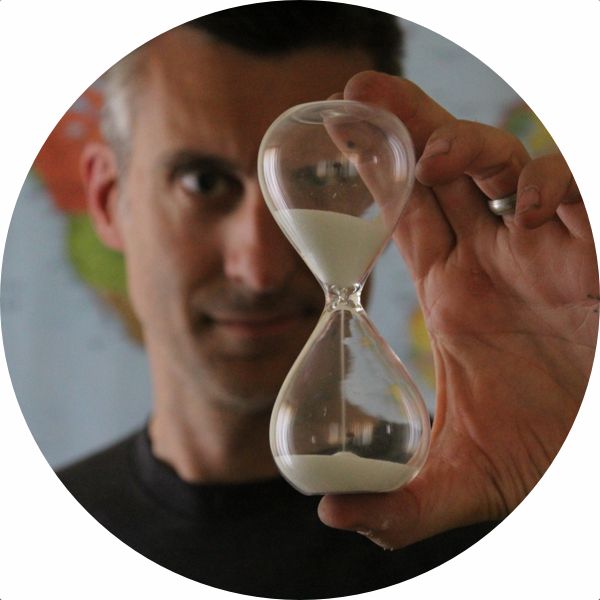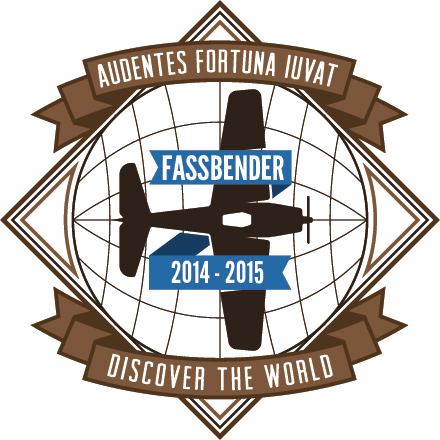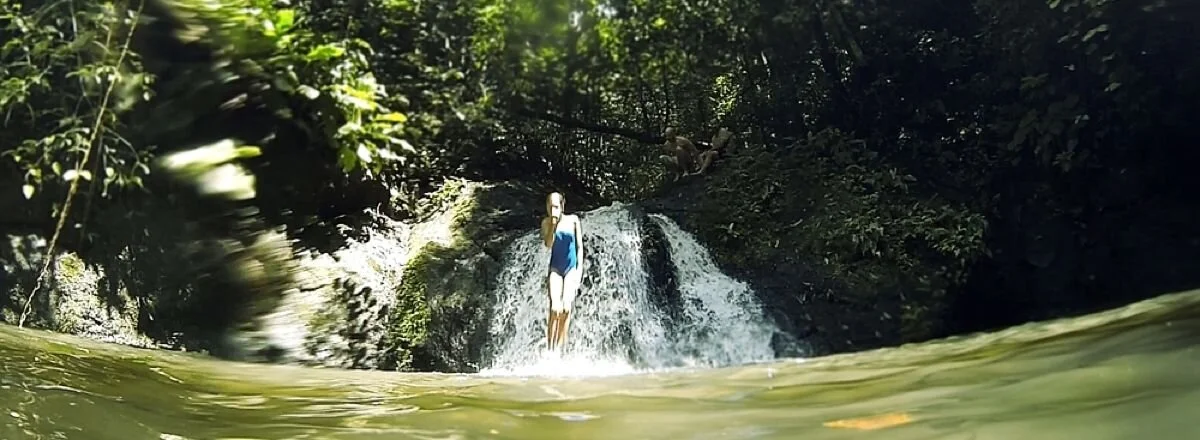Thursday, 28-08-2014. Day 9.
Crossroads of the Americas.
The bus arrived at the Albrook Bus Terminal (also known as the Gran Terminal Nacional de Transporte) at 5:00 a.m. Despite the the early hour, the place was bustling. We retrieved our luggage quickly and headed toward the bathroom. And here’s the first funny thing about Panama: you need a quarter (U.S. or Panamanian) to get into the bathrooms. And even funnier, coming from Costa Rica, all we had for coins was colónes.
The official currency of Panama is the Balboa, but it has the exact same value and size as U.S. currency. We later learned that it’s even minted in the U.S. (although I can’t say if that’s true or not). But all the Panamanian ATMs dispense dollars. We never saw any paper Balboas, only coins.
Dos Balboas.
Fortunately, I had a few U.S. dollars, so I bought a bag of peanuts from a vending machine for 25 cents and got three bathroom admissions in return.
We had four hours to kill until our tour guide (from Panama Roadrunner) would pick us up, so we went to a waiting room and charged our near-empty devices — 16 hours with no power had them running on their last few electrons.
A few years ago, I read a tweet (that I can’t find now) comparing the modern search for power outlets to keep devices charged to Pac-Man’s endless munching of power pellets. It was amusing at the time, but it really hits home now. We’re always on the look out for available power outlets. Speaking of outlets, they’re the same here and in Costa Rica as the U.S.A.
An open outlet in a church. We didn’t use this one.
We got hassled by the man for hanging out in the waiting room. Weird, right? It’s a waiting room. We were waiting. But whatever, it was breakfast time anyway so we moved to the food court. Our options here were limited and very norteamericano: Burger King, Dairy Queen, KFC, Pizza Hut, McDonald’s, Dunkin’ Donuts. Despite this, and despite the dollar being the unit of currency, Panama is not an English-friendly country.
My Spanish is barely passable under the best circumstances (though I’ve gotten much better in the past eight days). I can read it well enough and speak it all right, but it takes me awhile to form the sentences in my head before I speak — mainly because I’m trying to find the right tenses for the the right words. But when spoken to, the words often go by faster than I can process (Por favor, hable más despacio) and I miss a lot. It probably really sucks talking to me.
In Costa Rica, people were forgiving of my poor verbal skills. But in Panama no quarter was given in the arena of conversation. Combine that with the second funny thing about Panama: the dialect. Some consonants sound different and every so often the speaker would mix in some English words, so I found I had to take extra time to process what was being said. It made for interesting and frustrating communication on both sides. And very humbling.
So, yeah, the Dunkin’ Donuts people didn’t like my non-Panamanian dialect coupled with my poor Spanish, a scenario that would play out many times over the next few days, but we managed to get some crappy coffee and a breakfast bagel anyway.
We sat (well, loitered, really) in the court until 8:30 when it was time to meet our tour guide. As we waited in the main concourse, we watched the colorful Panamanian buses drive in and out of the terminal, honking, showing off their fancy bus designs, and in general trying to drum up business.
Some of the famous buses of Panama.
Soon enough our tour guide Ruth (a Canadian expat who, nine years ago, came to visit Panama for three weeks and never left) found us and we left the Albrook Bus Terminal, heading for the Miraflores Locks, part of the Panama Canal.
Panama Canal
We got there just in time to see a ship, the Box Queen, a Panamax ship (which has hence been renamed the Bangsa and subsequently decommissioned), pass through the Miraflores Locks from the Pacific side.
Each lock (there are three sets per side) fills with 26 million gallons of water that flows in from nearby Lake Gatún in the time it takes to fill a bathtub. Watching the locks in action was really fascinating, and a great point of discussion for the kids.
Miraflores Locks.
The locks are 110 feet wide, and the Box Queen had a mere 2 feet of clearance on each side as she moved through. To help keep her from sliding sideways and banging into the locks, she was held in place with the assistance of “mules” (because this job used to be done by mules) a series of paired electric locomotives that move along rails along with the ship.
It takes a ship between eight to 10 hours to pass through the locks, and only one ship can go at a time. This means that ships have to stop and wait in the ocean until their spot opens up. Some ships can wait up to 48 hours before they’re granted entry. Depending on the weight of their cargo, it costs ships between $200,000 and $500,000 in cash (wire transfer, really) before they can enter the locks.
Waiting for the man: Ships on the horizon waiting for access to the locks.
The big talk was about the new locks, which will allow for larger ships and faster crossings. These were supposed to have opened in time for the canal’s 100th anniversary on 16 August 2014, a few weeks before we visited. But turns out it’s a lot of work moving that much earth, and the opening date has been extended a few years. (Update: the new locks opened on 26 June 2016).
Centro Artesenal Amador
After our tour of the locks we went to the Centro Artesenal Amador, a local market where vendors hawked all sorts of trinkets, both Panamanian and otherwise. Ruth told us about mola, the traditional cloth-based art form of the Kuna, the indigenous people of Panama. Ruth showed us the difference between authentic mola made in the traditional style and newer mola made with more modern sewing techniques.
We had lunch on the Amador Causeway, which is a big weekend draw for local Panamanians. We didn’t spend much time here, but we did drive by the Biomuseo, which was designed by Frank Gehry. I didn’t get a good photo because I was in a car and the building was surrounded by a wire fence, but it looked like a Gehry building. If you really want to see it, here you go.
Casco Viejo
We spent some time walking around Casco Viejo, the old part of Panama City that’s going under some serious renovation.
Street corner, Casco Viejo.
The whole district is a mix of old, crumbling buildings and new, hip businesses. It felt a little like York Blvd back home in Los Angeles, but a lot more tightly packed, like if York Blvd was in New Orleans.
This is a former brothel in Casco Viejo. You can tell because of the leg.
The central government is in Casco Viejo, and there were many state police in the area. You could tell them apart from the tourist police by their burgundy berets. There was another type of police as well, but I’m not sure what they were called.
On our way out of Casco Viejo, we strolled by a row of street vendors selling all sorts of goodies. Jackie loves to shop and had to stop at each and every booth to check out what they were selling. Each girl got to buy a mola for their collection of “countries visited” patches.
Vendor row.
Panama Hats
Victor's genuine Panama hat.
Of course you can’t talk about Panama without talking about Panama Hats, which are actually Ecuadorian in design. But they’re everywhere, but, as far as I could tell, only tourists wore them.
Caps for sale: Panama Hats sold everywhere,
As we drove around, Ruth told us about Panamá Viejo, the ruins of the first old city that was destroyed when the dread pirate Captain Morgan (you might know him best as that rum guy) sacked the city in 1671. The site was closed for the day, so we didn’t go there, but we decided to visit it the next day.
We couldn’t check into our hi-rise Airbnb apartment until 5:30 p.m., and we still had about an hour to burn, so Ruth kindly took us shopping at the Super 99 to pick up a few groceries.
Then we spent too long actually looking for the place we were staying. As Ruth explained, Panamanians aren’t great with directions or identifying their buildings. This certainly was true in this case, but after a few missteps, we found our destination and, in short order, settled in. It had been a long day, so we cooked then ate dinner and turned in early.
Notable Statistics
Quarters used for bathroom access: 5
Panamanian buses seen: many
Ships traversing the canal: 1
Panama hats seen: hundreds
Header image: The Box Queen traversing the Panama Canal. Photo from the author’s collection.

Tom Fassbender is a writer of things with a strong adventurous streak. He also drinks coffee. If you enjoy his writing here and want to lend your support, you are welcome to contribute to his coffee fund.

















